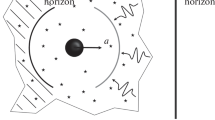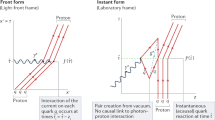Abstract
The possibility of an extrinsic origin for inertial reaction forces has recently seen increased attention in the physical literature. Among theories of extrinsic inertia, the two considered by the current work are (1) the hypothesis that inertia is a result of gravitational interactions and (2) the hypothesis that inertial reaction forces arise from the interaction of material particles with local fluctuations of the quantum vacuum. A recent article supporting the former and criticizing the latter is shown to contain substantial errors.
Similar content being viewed by others
REFERENCES
R. J. Adler, B. Casey, and O. C. Jacob, Am. J. Phys. 63, 720 (1995).
R. Loudon, The Quantum Theory of Light (Clarendon Press, Oxford, 1982).
P. Ramond, Field Theory–A Modern Primer (Beryaunka, Menlo Park, CA, 1981), pp. 55.
A. D. Sakharov, Dokl. Acad. Nauk SSSR 177, 70 (1968); translated in Sov. Phys. Dokl. 12, 1040 (1968).
Ya. B. Zel'dovich, Usp. Fiz. Nauk. 95, 209 (1968); translated in Sov. Phys. Usp. 11(3), 381 (1968).
S. L. Adler, Rev. Mod. Phys. 54, 729 (1982).
H. E. Puthoff, Phys. Rev. A 39, 2333 (1989).
J. V. Woodward and T. Mahood, Found. Phys. (1999), in press.
B. Haisch, A. Rueda, and H. E. Puthoff, Phys. Rev. A 49, 678 (1994).
A. Rueda and B. Haisch, Phys. Lett. A 240, 115 (1998); Found. Phys. 28, 1057 (1998).
A. Einstein, Ann. Phys. 49, 769 (1916), as quoted in H. C. Ohanian and R. Ruffini, Gravitation and Spacetime, 2nd ed. (W. W. Norton, New York, London, 1994), p. 53.
D. W. Sciama, Mon. Not. Roy. Astron. Soc. 113, 34 (1953).
U.S. Patent 5,280,864, Inventor: J. F. Woodward.
J. F. Woodward, Representation to NASA Breakthrough Propulsion Physics Workshop, Cleveland, OH, Aug. 12-14, 1997, Proceedings NASA Breakthrough Propulsion Physics Workshop, NASA-CP-1999-208694 (1999), p. 367.
W. Rindler, Phys Lett. A 187, 236 (1994).
K. Nordtvedt, Int. J. Theor. Phys. 27, 1395 (1988).
S. Haroche and J. M. Raimond, Sci. Am. 268(4), 54 (1993).
W. McCrea, Q. J. Roy. Astron. Soc. 27, 137 (1986).
J. T. Cushing and E. McMullin (eds.), Philosophical Consequences of Quantum Theory (University of Notre Dame Press, Notre Dame, IN, 1989).
J. R. Letaw, Phys. Rev. D 23, 1709 (1981), P. G. Grove and A. C. Ottewill, Class. Quantum Grav. 2, 373 (1985).
D. C. Cole and A. Rueda (1999), in preparation. D. C. Cole (1999), in preparation.
Author information
Authors and Affiliations
Rights and permissions
About this article
Cite this article
Dobyns, Y., Rueda, A. & Haisch, B. The Case for Inertia as a Vacuum Effect: A Reply to Woodward and Mahood. Foundations of Physics 30, 59–80 (2000). https://doi.org/10.1023/A:1003639008887
Issue Date:
DOI: https://doi.org/10.1023/A:1003639008887




